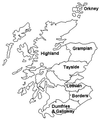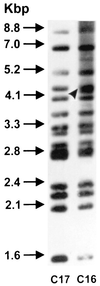Epidemiological study of paratuberculosis in wild rabbits in Scotland
- PMID: 10325318
- PMCID: PMC84940
- DOI: 10.1128/JCM.37.6.1746-1751.1999
Epidemiological study of paratuberculosis in wild rabbits in Scotland
Abstract
A survey of 22 farms confirmed the presence of paratuberculosis in wild rabbits in Scotland. Regional differences were apparent in the prevalence of the disease in rabbits, with a significantly higher incidence occurring in the Tayside region. Statistical analysis showed a significant relationship between a previous history or current problem of paratuberculosis in cattle and the presence of paratuberculosis in rabbits on the farms. Molecular genetic typing techniques could not discriminate between selected rabbit and cattle isolates from the same or different farms, suggesting that the same strain may infect and cause disease in both species and that interspecies transmission may occur. The possibility of interspecies transmission and the involvement of wildlife in the epidemiology of paratuberculosis have important implications for the control of the disease.
Figures




Similar articles
-
Occurrence of Mycobacterium avium subspecies paratuberculosis across host species and European countries with evidence for transmission between wildlife and domestic ruminants.BMC Microbiol. 2009 Oct 7;9:212. doi: 10.1186/1471-2180-9-212. BMC Microbiol. 2009. PMID: 19811631 Free PMC article.
-
Molecular epidemiology of Mycobacterium avium subsp. paratuberculosis: IS900 restriction fragment length polymorphism and IS1311 polymorphism analyses of isolates from animals and a human in Australia.J Clin Microbiol. 2000 Sep;38(9):3240-8. doi: 10.1128/JCM.38.9.3240-3248.2000. J Clin Microbiol. 2000. PMID: 10970365 Free PMC article.
-
Paratuberculosis in wild rabbits (Oryctolagus cuniculus).Vet Rec. 1997 Feb 8;140(6):141-3. doi: 10.1136/vr.140.6.141. Vet Rec. 1997. PMID: 9050174
-
Do non-ruminant wildlife pose a risk of paratuberculosis to domestic livestock and vice versa in Scotland?J Wildl Dis. 2003 Jan;39(1):10-5. doi: 10.7589/0090-3558-39.1.10. J Wildl Dis. 2003. PMID: 12685064 Review.
-
Molecular Epidemiology of Mycobacterium avium subsp. paratuberculosis on Dairy Farms.Annu Rev Anim Biosci. 2016;4:155-76. doi: 10.1146/annurev-animal-021815-111304. Epub 2015 Nov 2. Annu Rev Anim Biosci. 2016. PMID: 26526547 Review.
Cited by
-
Molecular epidemiology of Mycobacterium avium subsp. paratuberculosis isolates recovered from wild animal species.J Clin Microbiol. 2004 Apr;42(4):1703-12. doi: 10.1128/JCM.42.4.1703-1712.2004. J Clin Microbiol. 2004. PMID: 15071028 Free PMC article.
-
Occurrence of Mycobacterium avium subspecies paratuberculosis across host species and European countries with evidence for transmission between wildlife and domestic ruminants.BMC Microbiol. 2009 Oct 7;9:212. doi: 10.1186/1471-2180-9-212. BMC Microbiol. 2009. PMID: 19811631 Free PMC article.
-
A novel multi-antigen virally vectored vaccine against Mycobacterium avium subspecies paratuberculosis.PLoS One. 2007 Nov 28;2(11):e1229. doi: 10.1371/journal.pone.0001229. PLoS One. 2007. PMID: 18043737 Free PMC article.
-
Routes of intraspecies transmission of Mycobacterium avium subsp. paratuberculosis in rabbits (Oryctolagus cuniculus): a field study.Appl Environ Microbiol. 2006 Jan;72(1):398-403. doi: 10.1128/AEM.72.1.398-403.2006. Appl Environ Microbiol. 2006. PMID: 16391070 Free PMC article.
-
Field evaluation of the P22 ELISA for diagnosis of caprine tuberculosis in an endemic area.Front Vet Sci. 2025 Jul 24;12:1628812. doi: 10.3389/fvets.2025.1628812. eCollection 2025. Front Vet Sci. 2025. PMID: 40777827 Free PMC article.
References
-
- Angus K W. Intestinal lesions resembling paratuberculosis in a wild rabbit (Oryctolagus cuniculus) J Comp Pathol. 1990;103:101–105. - PubMed
-
- Challans J A, Stevenson K, Reid H W, Sharp J M. A rapid method for the extraction and amplification of Mycobacterium paratuberculosis DNA from clinical samples. Vet Rec. 1994;134:95–96. - PubMed
-
- Chiodini R J, van Kruiningen H J, Merkal R S. Ruminant paratuberculosis (Johne’s disease): the current status and future prospects. Cornell Vet. 1984;74:218–262. - PubMed
-
- Chiodini R J, Van Kruiningen H J. Eastern white-tailed deer as a reservoir of ruminant paratuberculosis. J Am Vet Med Assoc. 1983;182:168–169. - PubMed
-
- Feizabadi M M, Robertson I D, Hope A, Cousins D V, Hampson D J. Differentiation of Australian isolates of Mycobacterium paratuberculosis using pulsed-field gel electrophoresis. Aust Vet J. 1997;75:887–889. - PubMed
Publication types
MeSH terms
LinkOut - more resources
Full Text Sources

